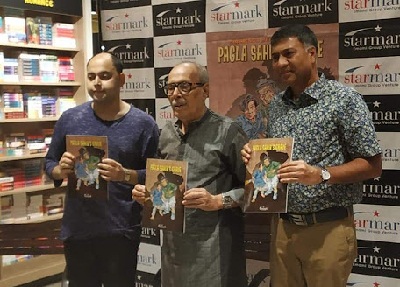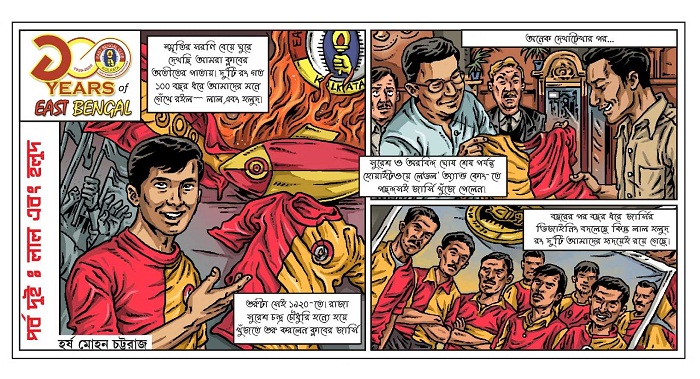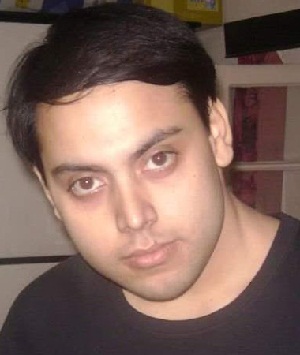In the era taken over by digitisation where almost every individual is glued to screens in front of them, be it a cell phone or anything else, a book or a comic book on a sun kissed afternoon or a lonely night becomes a much awaited recluse or escape. No matter how old one gets, especially in the times of ebooks and kindles, black words running on the white page accompanied with amazing artworks that take you some parallel universe, always create amazement.
 Probably that has still kept artists illustrators like Harsho Mohan Chattoraj producing some wonderful work in that genre. In fact, his latest artwork in graphic novel, Pagla Sahib’s Grave that released last Saturday, 16 November in Kolkata, has garnered positive response and appreciation.
Probably that has still kept artists illustrators like Harsho Mohan Chattoraj producing some wonderful work in that genre. In fact, his latest artwork in graphic novel, Pagla Sahib’s Grave that released last Saturday, 16 November in Kolkata, has garnered positive response and appreciation.
Pagla Sahib’s Grave is an English translation of the popular Bengali novella, Pagla Saheber Kobor by Shirshendu Mukhopadhyay. For the Bengali readers, Mukhopadhyay has been a fan favourite since time immemorial in comedy. Published by Starmark, the script is penned by Suvorup Bhattacharjee, editing is done by Arundhati Gupta. Chattoraj was the colorist and letterer for the book.
Mentions Chattoraj about working on this project, “His [Mukhopadhyay] stories are so clear and his narrative structure is right from his heart. And that helps in many ways to alleviate our worries and answer our queries. I am deeply influenced by elements of Mike Mignola, Eduardo Risso and Debashish Deb. Their work style, helped me give my level best.”
For Chattoraj, it all started with a cartoon and comic column in the Statesman, and a comic scripted and drawn in collaboration with a friend, Avik Kumar Maitra, for the Sandesh magazine some seventeen years back. After that, he has drawn comics for clients in the US, UK, Australia, in magazines like Strapazin and Reportagen in Switzerland, as well as for Indian publishers and magazines. Some of his works are Kolkata Kaleidoscope (for SpeechBubble), Ghosts of Kingdoms Past (for Penguin) and Chakrapurer Chakkare (for Starmark ) which he also penned and Hyderabad Graphic Novel, wherein he collaborated with the writer Jai Undurti. He is a noted artist and well-known in the industry for his unique style and research that he puts behind.

Adds He, “Pagla Sahib’s Grave deals with the adventures of a man, when he has to shift to the village scenario from his more familiar cityscape, and how he deals with the troubles that he encounters. So, There’s a subtle difference between the earlier graphic novel I did for Starmark, Chakrapurer Chakkare where I was the scriptwriter as well. But for the last few years, I have tried to focus more on art than scripting, and Pagla Sahib’s Grave is one of the projects where I have focussed on just art, colours and lettering. The style is a bit different, as it’s like some magic aura, that changes one way or another, as the years pass. But getting references was always a tantalizing problem for me. For Pagla Sahib’s Grave, that was tough as this time I wasn’t scripting the comic myself, and had to broaden my outlook while hunting for the references, as the final art would be based partially on the thoughts of the scriptwriter.”
He has also worked on a graphic novel on Netaji, a comic for the doctors at AIIMS, the webcomic for Moneycontrol, Where Did My Profits Go?, a book on GST and a comic strip that comes weekly in Ei Shomoy newspaper, a part of TOI group called 100 Years of East Bengal. So far, five strips have been published. He also has another graphic novel scheduled for the end of this month titled Destiny Awakes. Penned by Adam First it’s a 48 page comic, to be launched in Delhi.
For 100 Years of East Bengal, he had to do a lot of research. He says, “Being more of a cricket, table tennis and erstwhile WWF / WWE fan, my knowledge of football in India wasn’t much. So I had to do my research and received lots of help from documents, histories, data from the folks at East Bengal. Big thanks goes to Parijat Maitra of East Bengal, who archives the team’s data, for getting me a lot of information on the history, not to mention the photo references I desperately required. Not only did the folks at East Bengal give me the references I needed, but I was also able to do the necessary photoshoot at the club and get more important inputs, which helped me no end.”

Throwing some more light on technicalities, Chattoraj informs. “Personally, I always preferred drawing on paper. Namely, pencilling and inking and the colouring is done digitally. I remember having to use a mouse when colouring a decade back, when the Wacom tablet was not yet so widely used. Can’t imagine how I managed it then! My process of taking on the artwork of any comic page is three-fold. First step is to create a rough layout, where I ideate the poses, the camera angles and zoom factors. Next comes the penciling and inking stage on paper, and thirdly, the digital means are used to scan the artwork in, do the colors and then layout the page, following which a different software is used to do the lettering, a seemingly easy but jolly important task.”

Despite producing some great work, Chattoraj thinks this industry is lacking as there are no means of steady income by just creating comics. Those who are in this field, have had to branch out to other sections, like drawing illustrations and storyboards, creating concept sketches, to sustain us. Not to mention that the amount paid by the big publishing houses of India is pitifully low, when it comes to comics.
“In most other countries which have had a history of comics, there is a proper link between films and comics, where each help the other out. When the Comic Con started, the industry seemed to have found a new opening, a new high. Sadly, that tapered down as the years passed, in spite of great art and scripts from the creators and comic companies. If the publishers and comic houses help the creators because India does have a vast talent in both writing and drawing, whether it be in the arena of comics or books – we will rise again. However, I should mention that I keep seeing great comics and graphic novels being created by my friends and colleagues, and I wish them the best. Clearly the quality of work, of output in the form of comics has soared, and doubled. It’s up to the publishers and readers to utilize this is the best way. I can only wish that the great film-making community here will open up their arms and embrace the potential of comics,” concludes he.
We just hope these talented artists who produce incredible work, get their due that’s long denied to them.

